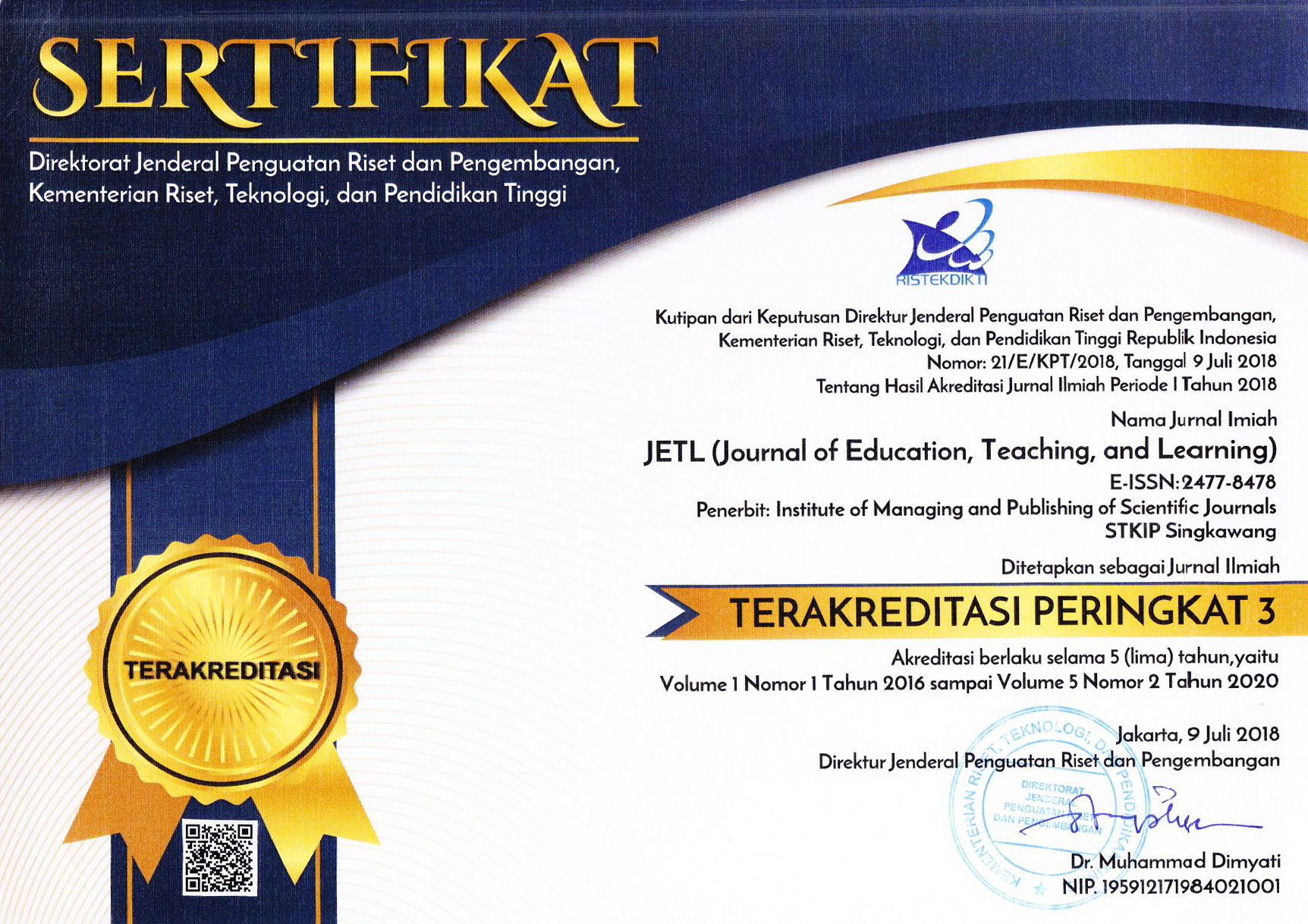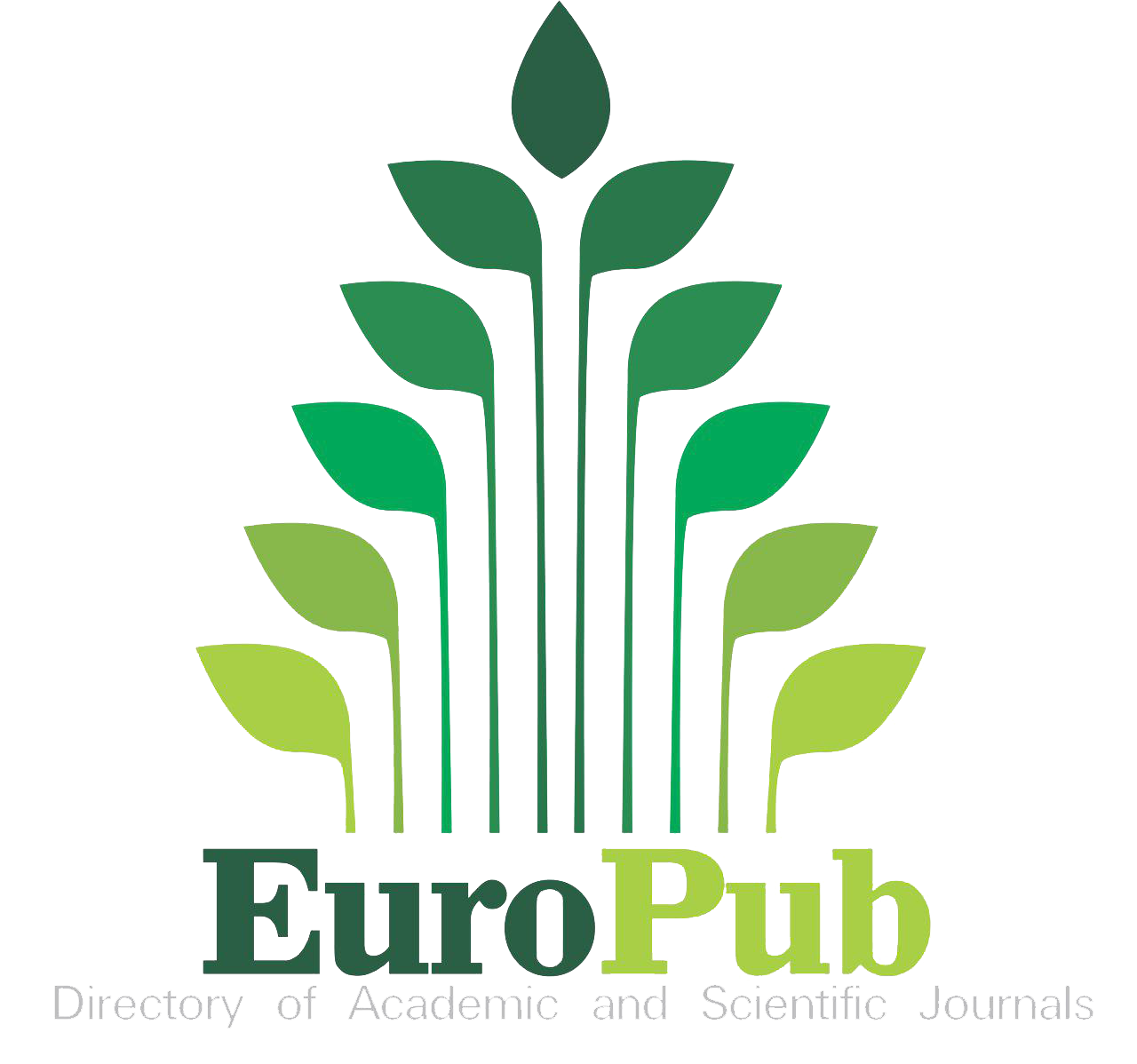The Development of Digital Pocketbook Based on the Ethnoscience of the Singkawang City to Increase Students' Scientific Literacy on Heat Matter and Its Transfer
Abstract
Keywords
Full Text:
PDFReferences
Ahmadi, I.K., Sofan, & Tatik. (2012). Mengembangkan Pendidikan Berbasis Keunggulan Lokal dalam KTSP. Jakarta : Prestasi Pustakaraya.
Astuti, W. P., Prasetyo, A. P. B., & Rahayu, E. S. (2012). Pengembangan instrumen asesmen autentik berbasis literasi sains pada materi sistem ekskresi. Lembaran Ilmu Kependidikan, 41(1).
Fikri, M. R., Milama, B., & Yunita, L. (2019). Pengembangan Buku Pengayaan Kimia Berorientasi Etnosains Kampung Setu Babakan Dki Jakarta. JTK: Jurnal Tadris Kimiya, 4(2), 136-146.
Hamzah, Amir. (2018). Pendidikan Sains dan Teknologi penting dalam Kemajuan Bangsa. https://akprind.ac.id/pendidikan-sains-dan-teknologi-penting-dalam-kemajuan-bangsa/. Accessed 14 August 2019.
Indriani. (2016). Peringkat PISA Indonesia Alami Peningkatan. http://www.antaranews.com/berita/600165/peringkapisa-indonesia-alami-peningkatan. Retrieved 18 January 2019.
Istiningrum, R., Amin, M., & Lestari, U. (2016). Pengembangan Buku Ajar Biologi Sel Berbasis Bioinformatika. Jurnal Pendidikan: Teori, Penelitian, dan Pengembangan, 1(9), 1693-1699.
Jannah, D. F., & Dwiningsih, K. (2013). Kelayakan Buku Ajar Kimia Berorientasi Quantum Learning Pada Materi Pokok Kimia Unsur Untuk Siswa Kelas XII SMA (Feasibility Of Chemistry Textbook Oriented Quantum Learning In The Matter Of Chemical Elements For Class Xii High School). Unesa Journal of Chemical Education, 2(2).
Kartono, K., Hairida, H., & Bujang, G. (2010).Penelusuran Budaya dan Teknologi Lokal dalam Rangka Rekonstruksi dan Pengembangan Sains di Sekolah Dasar (Kajian Etnosains dan Etnoteknologi terhadap Masyarakat Tradisonal Lingkungan Pertanian Suku Melayu dan Dayak di Kabupaten Pontianak). Jurnal Cakrawala Kependidikan, 9(1), 218573.
Kementerian Pendidikan dan Kebudayaan. (2012). Dokumen Kurikulum 2013. Tersedia di http://kangmartho.com/ tanggal 10-04-2013].
Martin, M O et al. (2015). TIMSS 2015: International Results in Science. Boston: TIMSS & PIRLS International Study Center.
Muhardini, S., Rahman, N., Mahsup, M., Sudarwo, R., Anam, K., & Fujiaturrahman, S. (2020). Pengembangan Media Pembelajaran Box Nusantara untuk Membentuk Kemampuan Memahami Konsep Tematik pada Siswa Sekolah Dasar. Jurnal Kependidikan: Jurnal Hasil Penelitian dan Kajian Kepustakaan di Bidang Pendidikan, Pengajaran dan Pembelajaran, 6(2), 284-291.
Nofiana, M., & Julianto, T. (2018). Upaya Peningkatan Literasi Sains Siswa Melalui Pembelajaran Berbasis Keunggulan Lokal. Biosfer: Jurnal Tadris Biologi, 9(1), 24-35.
Oyewusi, F & Ayanlola, A . (2014). Effect of mobile phone use on reading habits of private secondary school Students in Oyo State, Nigeria. University of Ibadan, Nigeria, 20, 1.Accessed 2 May 2017, from https//www.questia.com/library/journal/IP33367089961/effect-of- mobile-phone-use-on-reading-habits-of-private.
Pursitasari, I. D., Suhardi, E., Ardianto, D., & Arif, A. (2019). Pengembangan Bahan Ajar Bermuatan Konteks Kelautan untuk Meningkatkan Literasi Sains Siswa. Jurnal IPA & Pembelajaran IPA, 3(2), 88-105.
Puskurbuk. (2014). Pedoman Penilaian Buku Nonteks. Jakarta : Depdiknas.
Rosyidah, A. N., Sudarmin, S. S., & Siadi, K. K. (2013). Pengembangan Modul IPA Berbasis Etnosains Zat Aditif dalam Bahan Makanan untuk Kelas VIII SMP Negeri 1 Pegandon Kendal. Unnes Science Education Journal, 2(1), 133-139.
Safitri, A. D., & Rusilowati, A. (2015). Pengembangan Bahan Ajar Ipa Terpadu Berbasis Literasi Sains Bertema Gejala Alam. UPEJ Unnes Physics Education Journal, 4(2).
Shidiq, A. S. (2016). Pembelajaran sains kimia berbasis etnosains untuk meningkatkan minat dan prestasi belajar siswa. In Seminar Nasional Kimia dan Pendidikan Kimia (SNKPK) VIII (pp. 227-236).
Sudarmin. (2014). Pendidikan Karakter, Etnosains dan Kearifan Lokal (Konsep dan Penerapannya dalam Penelitian dan Pembelajaran Sains). Semarang: Fakultas MIPA Universitas Negeri Semarang.
Supardi, et al. (2012). Pengaruh Media Pembelajaran dan Minat Belajar Terhadap Hasil Belajar Fisika. Jurnal Formatif, 2(1):71-81.
Suwarni, E. (2015). Pengembangan Buku Ajar Berbasis Lokal Materi Keanekaragaman Laba-Laba di Kota Metro Sebagai Sumber Belajar Alternatif Biologi Untuk Siswa SMA Kelas X. Bioedukasi, 6(2), 86-92.
Syahroni, M., Siti Nurrochmah, and Fahrial Amiq. (2016). Pengembangan Buku Saku Elektronik Berbasis Android Tentang Signal-Signal Wasit Futsal Untuk Wasit Futsal Di Kabupaten Pasuruan. Jurnal Jasmani, 26(2), 304-317
Yusuf , B. (2009). Esensi Penyusunan Materi Pembelajaran. Yogyakarta: CV Budi Utama.
DOI: http://dx.doi.org/10.26737/jetl.v5i2.2042
Refbacks
- There are currently no refbacks.

This work is licensed under a Creative Commons Attribution-NonCommercial 4.0 International License.
Published by:
Institute of Managing and Publishing of Scientific Journals STKIP Singkawang
Sekolah Tinggi Keguruan dan Ilmu Pendidikan (STKIP) Singkawang
Address : STKIP Singkawang, Jalan STKIP - Kelurahan Naram Singkawang, Kalimantan Barat, INDONESIA, 79251
No. Telp. : +62562 420 0344
No. Fax. : +62562 420 0584
JETL (Journal of Education, Teaching, and Learning)
e-ISSN : 2477-8478
p-ISSN : 2477-5924

Editor in Chief Contact: [email protected] / Wa: +6282142072788
Publisher Contact: [email protected] / Wa: +6282142072788
Management Tools
JETL Indexed by:
JETL (Journal of Education, Teaching, and Learning) is licensed under a Creative Commons Attribution-NonCommercial 4.0 International License.











